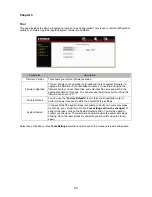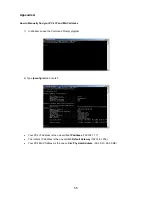
2.6.1 Virtual Server
Use the Virtual Server function when you want different servers/clients in your LAN to handle different
service/Internet application type (e.g. Email, FTP, Web server etc.) from the Internet. Computers use
numbers called port numbers to recognize a particular service/Internet application type. The Virtual Server
allows you to re-direct a particular service port number (from the Internet/WAN Port) to a particular LAN
private IP address and its service port number. (See Glossary for an explanation on Port number)
Parameter
Description
WAN Port Range
Enter the service (service/Internet application) port number from the Internet that
will be re-directed to the above Private IP address host in your LAN
Note
: Virtual Server function will have priority over the DMZ function if there is a
conflict between the Virtual Server and the DMZ settings.
Server IP Address
This is the LAN client/host IP address that the Public Port number packet will be
sent to.
Note
: You need to give your LAN PC clients a fixed/static IP address for Virtual
Server to work properly.
Server Port Range
This is the port number (of the above Private IP host) that the below Public Port
number will be changed to when the packet enters your LAN (to the LAN
Server/Client IP)
Protocol
Select the port number protocol type (TCP, UDP).
Click <
Apply>
at the bottom of the screen to save the above configurations. You can now configure other
advance sections or start using the router (with the advance settings in place)
Example: Virtual Server
The diagram below demonstrates one of the ways you can use the Virtual Server function. Use the Virtual
Server when you want the web server located in your private LAN to be accessible to Internet users. The
configuration below means that any request coming form the Internet to access your web server will be
translated to your LAN’s web server (192.168.2.2).
Note:
For the virtual server to work properly Internet/remote users must know your global IP address. (For
websites you will need to have a fixed/static global/public IP address)
40






























